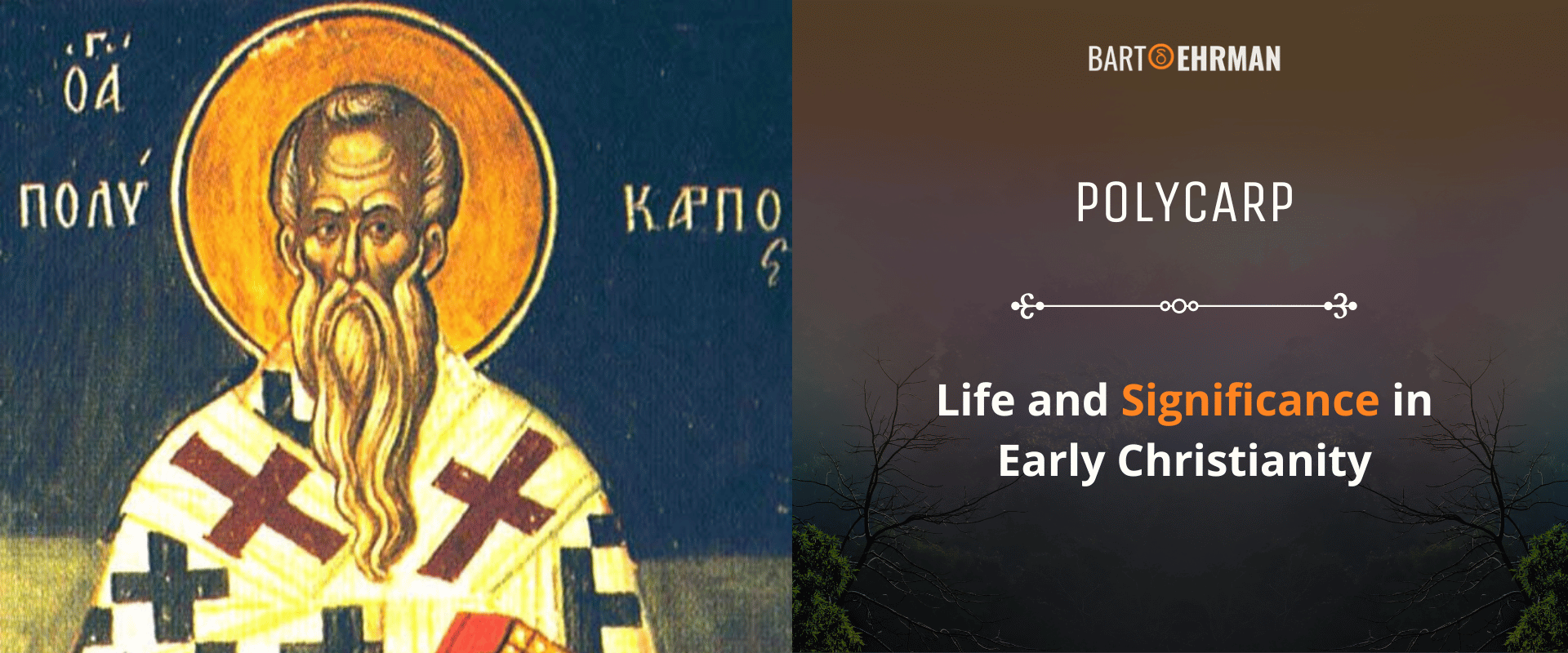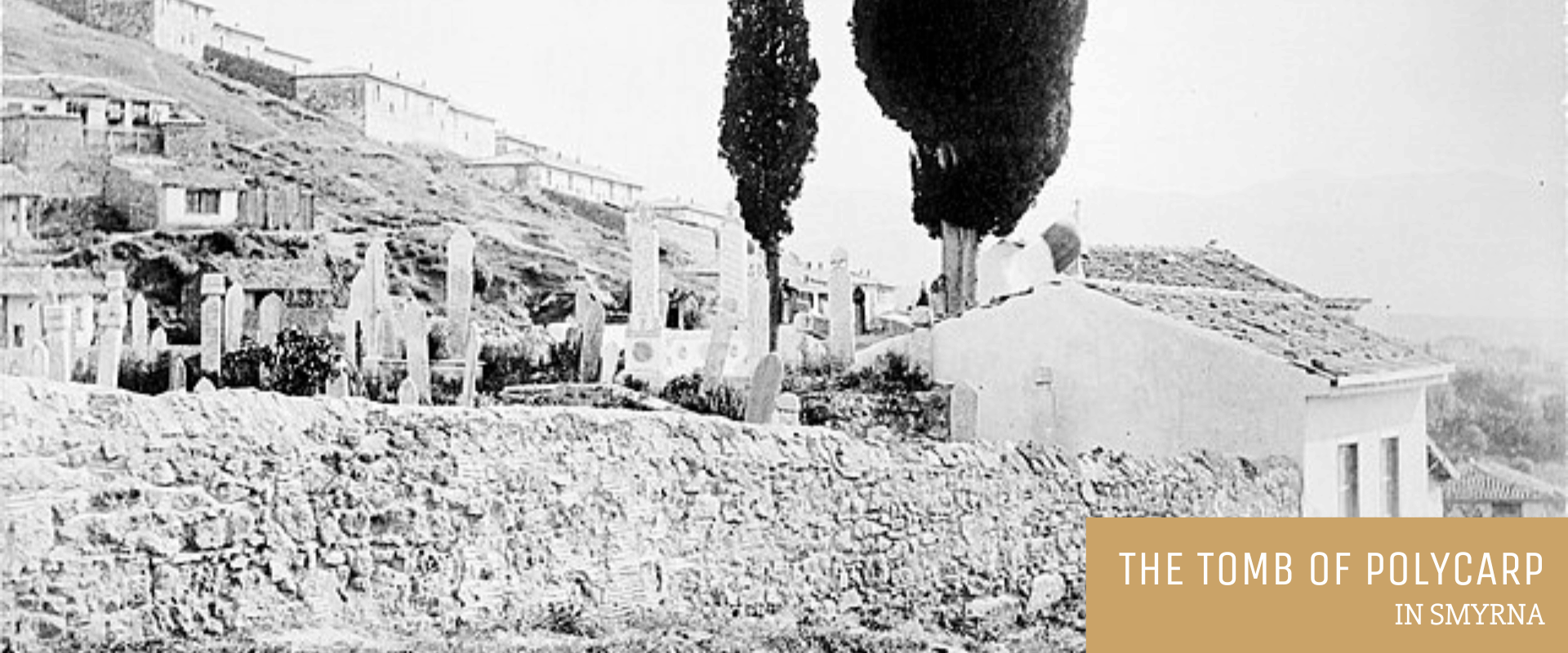Polycarp: Life and Significance in Early Christianity

Written by Joshua Schachterle, Ph.D
Author | Professor | Scholar
Author | Professor | BE Contributor
Verified! See our editorial guidelines
Verified! See our guidelines
Date written: May 29th, 2024
Disclaimer: The views and opinions expressed in this article belong to the author and do not necessarily match my own. - Dr. Bart D. Ehrman
Polycarp, a significant figure in 2nd-century Christianity, is renowned for his devout faith and leadership as the bishop of Smyrna. His connections with the original disciples of Jesus, particularly the Apostle John, have intrigued scholars and historians for centuries.
Did Polycarp really interact with John and other early disciples? This question remains a topic of fascinating debate. In this article, we will explore Polycarp’s life, his writings, and the accounts about him, shedding light on his importance and the veracity of his interactions with Jesus' original followers.

Who Was Polycarp? Birth and Death Years
Polycarp was born in 69 CE, probably in Smyrna in the Roman province of Asia Minor (modern-day Turkey) and died in that same city in 155 CE. We know that he was a bishop of Smyrna and wrote an important epistle to the Philippian church. However, like many ancient writers, Polycarp doesn’t give us a lot of autobiographical details in his own writing. For that reason, we have to rely on other ancient writers who wrote to him or about him for facts about his life.
Writings about Polycarp
One of the principal figures who wrote about Polycarp is the famous 2nd-century Christian author Irenaeus of Lyon. Irenaeus was a bishop in Lyon in the province of Gaul (modern-day France). He apparently wrote several books but the best-known by far is the five-volume work known as Against Heresies. This book does just what the title promises: it explains Christian heresies, as defined by Irenaeus himself, and condemns them.
As a young man, Irenaeus apparently heard Polycarp preach. He believed that Polycarp had actually known the Apostle John, son of Zebedee, and had heard him preach. Was this true?
It’s impossible to know for certain but consider this: Polycarp was born in the year 69 CE, about 40 years after the death of Jesus. If we assume that John was a young adult – let’s say he was 20 – when he knew Jesus, this would have made him 60 when Polycarp was born.
If Polycarp then heard John preach, even at the tender age of 20, John would have already been at least 80 years old. Hardly anyone in the ancient world lived past the age of 65. Of course, it’s possible that Polycarp heard John preach, but probably unlikely. Remember also that John was a Galilean peasant who spoke only Aramaic. Polycarp was a Roman citizen who seems to have spoken only Greek.
Nevertheless, Irenaeus writes this about Polycarp:
I could tell you the place where the blessed Polycarp sat to preach the Word of God. It is yet present to my mind with what gravity he everywhere came in and went out; what was the sanctity of his deportment, the majesty of his countenance; and what were his holy exhortations to the people. I seem to hear him now relate how he conversed with John and many others who had seen Jesus Christ, the words he had heard from their mouths.
Polycarp was already in his 60s when Irenaeus was born, so he was quite old by the time Irenaeus met him. However, Irenaeus clearly had great reverence for him and fond memories of hearing Polycarp’s wisdom.
Irenaeus also writes that when a man named Anicetus was bishop of Rome, Polycarp visited him to discuss some of the differences in the churches of Asia Minor and Rome. Irenaeus says that they easily came to an understanding on some issues, but never entirely agreed on the proper date for Easter. At the very least, this shows that Polycarp was considered a real authority for the Eastern Churches, representing them to the head of the Western Church.
In addition to Against Heresies, we have a work called The Martyrdom of Polycarp, which of course is about Polycarp’s death for his faith in the year 155 CE. It is written by someone named Evaristus, although it’s impossible to know if this was the letter’s composer or merely the scribe who took dictation. However, it is a fascinating piece of writing, the first account of Christian martyrdom outside the New Testament, in fact. But is it history? Let’s look at its contents.
Scholars have made various estimates about when The Martyrdom of Polycarp was written. Some believed it was written somewhere between 155 and 160 CE, in other words, right after the events it describes. Others believed it was written between 167-177 CE, based on references to it in the writings of Eusebius. Most recently, Candida Moss has argued that it was written in 200 CE or possibly later, which I’ll discuss further below.
It's written in the form of a letter on behalf of the church at Smyrna in Asia Minor (modern-day Turkey) where Polycarp had been the bishop. The letter is addressed to “the church of God that temporarily resides in Philomelium, and to all congregations of temporary residents everywhere, who belong to the holy and universal church.” Philomelium, by the way, was another city in Asia Minor.
In the letter, Polycarp is 86 years old and living in retirement in the country when he has a prophetic vision that he will be burned to death. He is later betrayed to Roman authorities who send guards out to his home to arrest him and bring him to a stadium in Smyrna. He is asked to swear by Caesar and to renounce Christ. Polycarp refuses and is sent to be burned alive.
However, the fire miraculously forms a ring around him and never touches him. He is then stabbed to death, but his spurting blood puts out the fire. The letter says that the Jews of Smyrna encourage the governor to burn the body so that Christians won’t be able to venerate it. However, after the body is burned, Christians gather the bones which the author says are “more valuable than expensive gems and more precious than gold, and put[s] them in a suitable place.” This indicates a cult of the veneration of martyrs.
While it is certainly plausible that Polycarp died a martyr, there are historical reasons to think that The Martyrdom of Polycarp is not a historically accurate account. Paul Foster and Sara Parvis, for example, point out that the depiction of Roman legal proceedings is highly improbable. Polycarp's trial is presided over by a leading magistrate of the Empire in a sports stadium, without a tribunal, formal legal accusation, or official sentence. Foster and Parvis believe that the inaccuracy of the trial account makes the story seem unreliable.
Bart Ehrman notes that “the Martyrdom was never meant to be a disinterested account of the death of Polycarp, but had from the outset literary pretensions and apologetic motives.”
More specifically, the practice of gathering the remains of a martyr and venerating them doesn’t occur in Polycarp’s time and, according to both Ehrman and Candida Moss, indicates a date sometime after 200 CE, making it even less likely that the letter was written by an eyewitness.
So what can we learn from these documents? Well, Polycarp was seen as authoritative because he was believed to have met and heard the preaching of John the Apostle. Whether this was true or not, his authority was never doubted by Polycarp’s disciples such as Irenaeus. In addition, he probably did die a martyr, although the Martyrdom of Polycarp was almost certainly fictitious in most aspects.
FREE COURSE!
WHY I AM NOT A CHRISTIAN
Raw, honest, and enlightening. Bart's story of why he deconverted from the Christian faith.
Over 6,000 enrolled!
Letter from Ignatius of Antioch
Ignatius of Antioch (d. about 140 CE) was a bishop of Antioch, Syria in the 2nd century. When he was arrested and transported to Rome to be executed, he wrote a number of surviving letters to churches and individuals. One of those individuals was Polycarp.
In the letter, Ignatius encourages Polycarp to behave morally and warns against various heresies going around at the time. He also asks Polycarp to write a letter on his behalf to his church in Antioch congratulating them on healing an apparent schism. He asks him to choose a reliable messenger to take it to Antioch:
It is fitting, O Polycarp, most blessed in God, to assemble a very solemn council, and to elect one whom you greatly love, and know to be a man of activity, who may be designated the messenger of God; and to bestow on him this honor that he may go into Syria, and glorify your ever active love to the praise of Christ.
He also asks Polycarp to send letters to various churches in Asia Minor, close to Polycarp’s home of Smyrna. Polycarp seems to have done this as evidenced by his letter to the church at Philippi which we’ll look at next.
What we learn about Polycarp from Ignatius’ letter is that he was a respected authority within the church at large and that Ignatius saw him as a faithful upholder of orthodoxy at a time when there were many competing versions of Christianity. I turn next to a letter written by Polycarp himself, the only surviving writing of his that we have.
What Did Polycarp Write and What Can It Tell Us?
When scholars first read Polycarp’s Epistle to the Philippians, they found something confusing. An early chapter of the letter praises Ignatius and two other martyrs for dying for their faith, but then a later chapter speaks as if Polycarp doesn’t actually know that Ignatius was martyred. Scholars, including Paul Hartog, have since realized that the Epistle is actually a composite of two different letters, the latter chapter being the first.
The letter consists of instructions for different groups of people within the Philippian church including wives, widows, deacons, young men, virgins, and elders. Here’s a brief summary of what Polycarp tells each group.
Wives: Be pure and love all equally. Teach your children to fear God.
Widows: Have self-control and pray for everyone.
Deacons: Be restrained in behavior and compassionate with everyone.
Young men: Be pure and blameless above all.
Virgins: Be pure and blameless.
Elders: Be compassionate and merciful to all.
None of this is revolutionary, of course. What is helpful for scholars, however, is that Polycarp refers to verses from Scripture (although not by name), helping us to understand what he and presumably most in his church felt to be Scripture at a time when the canon wasn’t yet fixed.
Most of Polycarp’s theology in this letter seems to come from the letters of Paul. This includes the authentic letters of Paul, but also the disputed Pauline letters including Ephesians, 1st and 2nd Timothy, and Jude. He also quotes from only two Gospels, Matthew and Luke, indicating perhaps that these were emphasized in his church over the Gospels of Mark and John.

Theology
Polycarp’s notion of salvation – this is called his soteriology – is that it comes through grace and not works as he quotes from Ephesians 2:8. However, he then encourages people to do good works as well, so his soteriology is not entirely clear. Some of this confusion may come from his using both authentic and disputed Pauline writings which often disagree.
He clearly opposed the heresy known as Docetism, a doctrine which said that Jesus was a purely spiritual being and only appeared to be a physical human being. He also opposed the teachings of Marcion, who had said that the Old Testament God was a different God from that of the New Testament. Marcion had therefore cut out the entire Old Testament from his self-created canon of Scriptures.
Finally, like the authentic letters of Paul, he believed in the resurrection of the dead and that Christ would return to earth as a judge.
Did You Know?
J. Warner Wallace, a homicide detective who works on cold cases, has also become a Christian apologist. He therefore applies the methods of cold-case investigation to biblical studies. As such, he uses an evidential principle called the “chain of custody” to determine whether Jesus’ resurrection can be supported by reliable evidence.
He says that the Apostle John wrote his eyewitness account of Jesus’ resurrection in the Gospel of John. John then directly handed that account over to Polycarp, who then handed it on to Irenaeus, and so on in an unbroken chain up to today. In other words, that first eyewitness account has been handed on through the ages intact and thus is reliable evidence for the resurrection.
The main problem with this assertion is that scholars have known for over a century that none of the Gospels are eyewitness accounts. They were first written anonymously and then later attributed, in the cases of Matthew and John, to apostles. Bart Ehrman says specifically that the Apostle John could not have written the Gospel of John.
Ehrman also says that even if eyewitnesses were still alive during the writing of the Gospels, none of those writers claims to have talked to those eyewitnesses. If we take away the assumption of eyewitness testimony, Wallace’s theory falls flat.
What Was Polycarp’s Significance for Early Christianity?
Polycarp lived and wrote in the 2nd century, between the composition of the New Testament and the later orthodoxy culminating in the Council of Nicaea. His Epistle to the Philippians is one of the earliest Christian writings we have outside the New Testament. It’s an important witness to what Christians in his time and place believed and practiced and which biblical books they saw as authoritative.
He was highly respected in his time, often referred to as “the most admirable Polycarp” by Irenaeus and other important Christian authors. He helped to define orthodoxy against heresy in the turbulent times of the 2nd century CE, especially against Marcionite and Docetic Christians.
As a martyr, Polycarp is an official saint. His relics are said to be buried in Rome under the church of Sant'Ambrogio della Massima. His feast day is February 23 in both the Roman Catholic and Eastern Orthodox Churches.
Conclusion
Polycarp of Smyrna was an important Eastern Christian bishop, one who was well-known and broadly admired by a number of early Christian authors. Our sources about him start with Irenaeus, Polycarp’s student and a bishop in his own right. According to Irenaeus, Polycarp had learned Christianity from the Apostle John and thus provided a link from Jesus to their time in the 2nd century.
In addition, The Martyrdom of Polycarp, we have a largely fictional document purporting to describe Polycarp’s martyrdom in a sports stadium in Smyrna. While Polycarp may indeed have been martyred, the ignorance the author of this document about Roman legal proceedings, as well as the veneration of Polycarp’s relics in the story demonstrate that it was probably written many decades after Polycarp’s death by a Christian apologist.
Polycarp also received a letter from fellow martyr Ignatius of Antioch who clearly had great respect for him and asked him to write letters on his behalf to other churches.
Polycarp’s own letter to a church at Philippi revealed that his theology was generally Pauline, although it made use of both genuine Pauline letters like Galatians and Romans and disputed Pauline letters like Ephesians and 1st and 2nd Timothy. The letter therefore gives us an idea of which biblical writings were considered authoritative for Christians in Polycarp’s time and place.
FREE COURSE!
WHY I AM NOT A CHRISTIAN
Raw, honest, and enlightening. Bart's story of why he deconverted from the Christian faith.
Over 6,000 enrolled!
